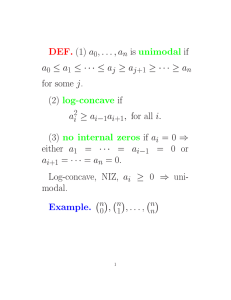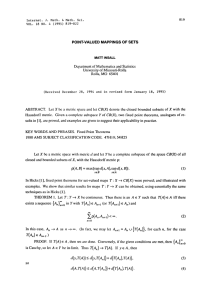Graphs and Combinatorics On the Number of Faces of Centrally-Symmetric
advertisement
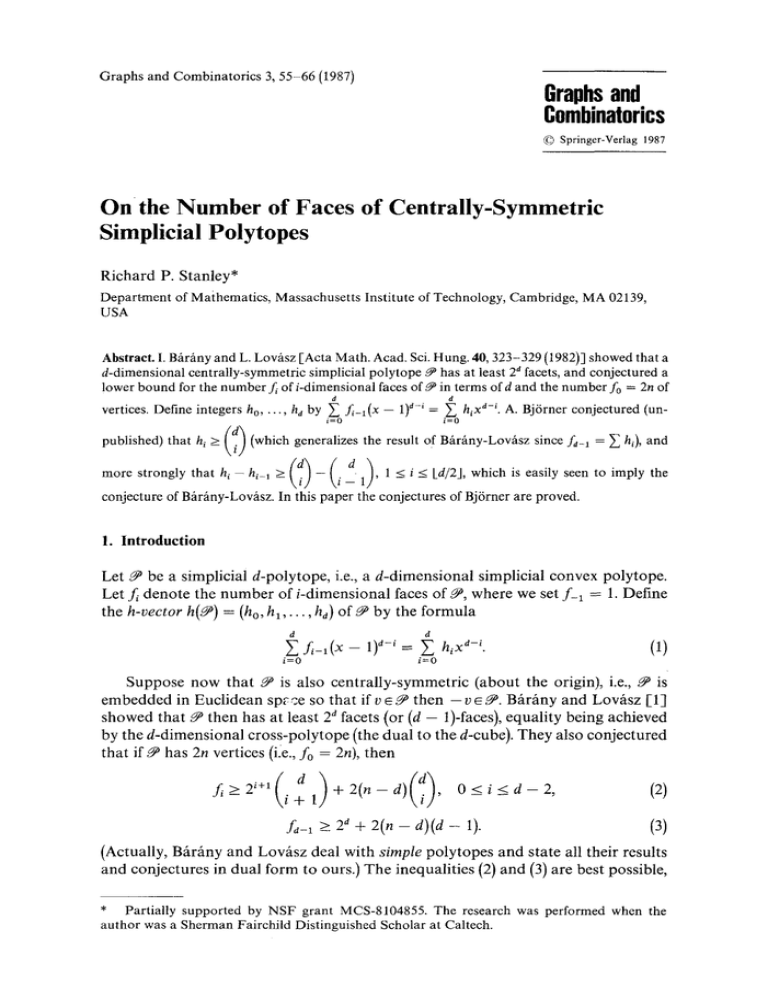
Graphs and Combinatorics 3, 55-66 (1987)
Graphs and
Combinatorics
© Springer-Verlag 1987
On the Number of Faces of Centrally-Symmetric
Simplicial Polytopes
Richard P. Stanley*
Department of Mai.hematics, Massachusetts Institute of Technology, Cambridge, MA 02139,
USA
Abstract. I. Bfirfiny and L. Lovfisz [Acta Math. Acad. Sci. Hung. 40, 323-329 (1982)] showed that a
d-dimensional centrally-symmetric simplicial polytope ~ has at least 2d facets, and conjectured a
lower bound for the number f~ of i-dimensional faces o f ~ in terms ofd and the number f0 = 2n of
d
vertices. Define integers ho..... he by Z f~-1(x - 1)d-' = ~ hixd-'. A. Bj6rner conjectured (uni=O
i=O
pub~ished) that hi > (di) (whi~ genera~ize~ the re~u~t ~f B~r~ny~L~v~ since f~-~ = ~ hi), and
m°restr°nglythath~-hH>(di)-(-
i d_.l) l<i<[d/2J,
_ _
conjecture of Bfirfiny-Lovfisz. In this paper the conjectures of Bj6rner are proved.
1. Introduction
Let N be a simplicial d-polytope, i.e., a d-dimensional simplicial convex polytope.
Let f~ denote the n u m b e r of/-dimensional faces of ~ , where we set f-1 = 1. Define
the h-vector h(~) = (ho,h I . . . . . he) of ~ by the formula
d
d
Z f/--l( "X'- 1)a - i = Z hi xa-i"
i=O
(1)
i=O
Suppose now that ~ is also centrally-symmetric (about the origin), i.e., ~ is
e m b e d d e d in Euclidean s p ~ e so that if v s ~ then - v ~ ~ . Bfirfiny and Lovfisz [1]
showed that ~ then has at least 2 d facets (or (d - t)-faces), equality being achieved
by the d-dimensional cross-polytope (the dual to the d-cube). They also conjectured
that if ~ has 2n vertices (i~e., fo = 2n), then
-
i+1
+2(n-d)
, 0_<i_d-Z,
L - , >-- 2" + 2(. - d)(d - 1).
(2)
(3)
(Actually, Bfirfiny and Lov~.sz deal with simple polytopes and state all their results
and conjectures in dual form to ours.) The inequalities (2) and (3) are best possible,
* Partially supported by NSF grant MCS-8104855. The research was performed when the
author was a Sherman Fairchild Distinguished Scholar at Caltech.
56
R.P. Stanley
since they can be achieved by taking the d-cross-polytope and applying n - d
successive pairs of stellar subdivisions of antipodal facets.
In terms of the h-vector, the inequality f~_~ _> 2e of Bfir/my-Lovfisz takes the
form
ho+hi +'"+ha>2
2•
Moreover, for any simplicial d-polytope we have hi = he-~ (the Dehn-Sommerville
equations) and 1 = h o < h~ <_... < hte/z I (the Generalized Lower-Bound Conjec/ T N
ture), as surveyed in [10]. For the d-cross-polytope we have h , = ( ~ ) . These
\
/
considerations led A. Bj6rner to conjecture (unpublished) that for any centrallysymmetric simplicial d-polytope ~ with h-vector (ho, hi ..... ha), we have
hi>_(di),
O<_i<_d,
(4)
and more strongly (since ho = 1),
hi-hi-l>
-
i-1
It is easily seen (see Corollary 4.2) that the inequalities (5)imply (2) and (3).
In this paper we will prove the conjectures (4) and (5) of Bj6rner. We will
establish (4) for a much broader class of objects than centrally-symmetric simplicial
polytopes, but for (5) we are unable to weaken these hypotheses. Briefly, the idea
behind the proofs is as follows. If A is a Cohen-Macaulay simplicial complex, then
the theory of Cohen-Macaulay rings shows that h~ > 0 by interpreting h; as the
dimension of a certain vector space A i. When in fact A is the boundary complex of
a simplicial polytope, the theory of toric varieties allows us to construct injective
linear transformations Ai_ 1 -* A i, 1 <_ i <_ [d/2]. Hence here we get h 0 <_ h~ _< ... _<
h~e/2~. When we have a group G of order 2 acting on A in a suitable way (which for
the boundary complex of a centrally-symmetric polytope is induced by the map
v ~ - v on N)then G acts on the vector spaces A~, and by decomposing this action
into isotypic components (with respect to the two inequivalent irreducible representations of G), we can improve the inequalities h~ _ 0 and ho < h~ < " " < hte/2 J
to (4) and (5), respectively.
2. Algebraic Background
We now review some algebraic concepts associated with simplicial complexes. See,
e.g., [2] or [10] for more details. Let A be an abstract simplicial complex on the
vertex set V = {xl ..... x,}. Let K be a field, and let I s be the ideal of the polynomial
ring K [ x l ..... x,] generated by all square-free monomials x q ' " x ~ r for which
{xi,, .... xir} ~A. Let K [ A ] = K [ x l . . . . . x , ] / I ~ , called the face ring (or StanleyReisner ring) of A. Let K[A]~ denote the space of all homogeneous polynomials of
degree i in K [ A ] , so K [ A ] has the structure
K [ A ] = K[A]o @ K [ A ] , O "
On the Number of Faces of Centrally-SymmetricSimplicial Polytopes
57
of a graded K-algebra. If dim A = d - 1 (i.e., the largest face F ~ A has d vertices),
then d is the maximum number of algebraically independent (over K) elements of
K[A] (or of K[A]I). A set 01 . . . . . OdeK[A]I is called a homogeneous system of
parameters (h.s.o.p.) of degree one if dim KK [A]/(O1.... ,0a) < oe. (This implies that
01 . . . . . Od are algebraically independent.) An h.s.o.p, of degree one always exists if
K is infinite, which for convenience we will assume henceforth.
We say that K[A] is Cohen-Macaulay (or that A is Cohen-Macaulay over K)
if for some (equivalently, every) h.s.o.p. 01, ..., Od of degree one, K[A] is a finitelygenerated free module over the polynomial subring K[01,. i., Od]. (Equivalently, 0~
is a non-zero-divisor m o d u l o (01 . . . . . 0i-1), ] ~_~ i ~_~ d.) Thus
t
K[A] = ~_I q~" K[Ox ..... Od], (vector-space direct sum)
(6)
I
where each t/i is a non-zero-divisor on K[01,..., Od]. We can choose each t/i to be
homogeneous, and conversely a set th . . . . . t/t of homogeneous elements of K[A]
satisfies (6) if and only if they form a K-basis of the quotient ring
A = g[.~]/(Ol,...
, Od).
The ring A inherits a grading A = A0 • A~ O ' " , and a simple counting argument
shows that
dim A i = hi(A ),
where A has f~ = f~(A)/-dimensional faces (so fo = n) and hl = hi(A)is defined by (1).
Let us recall the fundamental theorem of G. Reisner (see [8, Thm. 5] or [9,
p. 70]) characterizing Cohen-Macaulay complexes. Given any face F e A, define the
link of F by
l k F = {GsA" F U G E A and Ff~ G = Z~}.
In particular, lk N -- A.
Theorem 2.1. Let A be a (finite) simplicial complex. Then A is Cohen-Macaulay over
K if and only if for all F ~ A,
/41(lk F; K) = 0
if
i < dim(lk F),
where/4i(lk F; K) denotes reduced simplicial homology over K.
[]
In particular, all triangulations of spheres are Cohen-Macaulay. More generally
(e.g. [-8, Thm. 5]), the question of whether A is Cohen-Macaulay depends only on
the geometric realization [A[ of A.
We also need a characterization of h.s.o.p.'s of degree one in K[-A]. If
Y= Z ~x'xeK[zl]l
x~V
where c~x E K, then define the restriction YlF of y to the face F E A by
YlF = ~ c~x'x.
xEF
58
R.P. Stanley
L e m m a 2.2 (see, e.g., [2, p. 661). For any (d - 1)-dimensional simplicial complex A,
a set 01 . . . . , Od~K[A] 1 is an h.s.o.p, if and only if for all F ~ A , the vector space
spanned by 01 IF ..... Oel~ has dimension equal to IF[.
[]
3. Group Actions
N o w let G be a group of a u t o m o r p h i s m s of the simplicial complex A. Thus each
~ G is a bijection a: A ~ A such that i f F c F ' ~ A, then a(F) c a(F'). In particular,
a permutes the vertex set V, and a is completely determined by its action on V. We
say that G acts freely On A if for every a ~ 1 in G and every vertex x ~ V, we have
that x v~ a(x)and that {x,a(x)} is not an edge of A. Equivalently, for every x ~ V
the open stars of the elements of the orbit Gx are pairwise disjoint.
We come to the first of our two main results.
Theorem 3.1. L e t A be a (d - 1)-dimensional Cohen-Macaulay simplicial complex,
and suppose that a group G of order 2 acts freely on A. Then
hi(A) >_ (di),
O <_ i <_ d.
In particular,
fd-1 = ho + "'" + ha >- 2d"
Proof. Let G = { i, a}, and let K be a field of characteristic ~ 2. If W is any K-vector
space on which G acts, then define
W + ={w+W:a(w)=w}
w - : (w~ w: ~(w) : - w } .
it is clear that W = W + • W - . (In terms of representation theory, W + and W are the isotypic c o m p o n e n t s corresponding to the trivial and non-trivial irreducible
representations of G, respectively. However, G is such a "simple" group that there
is no need here to invoke explicitly the representation theory of finite groups.)
The action of G on A induces an action on the face ring K[A]. Let x ~ be a
m o n o m i a l in K[A] of degree i > 0. Since G acts freely on A, the K - s p a n of the
G-orbit of x ~ has a basis consisting of x ~ + a(x ~) ~ K [A] + and x ~ - a(x ~) ~ K [A]~-.
Hence
d i m K [ z J ] + = dimK[A]~- = ~ d i m K [ A ] ~ ,
i >_ 1.
(7)
Assume now K is infinite and (as above) char K ¢ 2. We claim there exists an
h.s.o.p. 01,..., O a ~ K [ A ] ~ o f K [ A ] . To see this, choose V' ~ V t o consist of exactly
one element from each G-orbit of V. Since K is infinite, there exist functions fl . . . . .
fa: V' ~ K such that the restrictions off1 . . . . . fa to any d-element subset of V' are
linearly independent. Extend f~, ..., fa to all of V by defining f~(a(x)) = -f~(x) for
On the Number of Faces of Centrally-Symmetric Simplicial Polytopes
59
x • V'. Define
2
xeV
Clearly 0~• K[A]7. Since x and a(x) are not both vertices of any face of A, it follows
from L e m m a 2.2 that 01 . . . . . 0d form an h.s.o.p., as desired.
Let A = K[A]/(OI ..... Od),with 01 . . . . , Odas above. Since a(O~)= -01, it follows
that G acts on the ideal (0a . . . . . 0d), and therefore on the graded algebra A =
Ao 03"" • Ad. We want to compute dim A + and dim Ai. Let q and t be indeterminates, and set t 2 = 1. If V = V0 ® 1/i ® "" is any graded vector space, with
dim Vii < o% on which G acts, set
r(V,q)
:
Z (dim
Vi)qi
i~O
and
F(V,q,t)= E
[(dim Vi+) + (dim
Vi-)t3q i.
i>_O
Since (see [10, eqn. (5)3)
F(K[A],q)
d
= (1 -
q)-d E hi(A)q i,
/=0
it follows from (7)that (writing
F(K[A],
hi = hi(A))
h i
q)~
i rX~d
q, t) = 1 + ~ L
(1 -
7
1~(1 + t).
(8)
(We have F(K [A], 0, t) = 1 since G fixes the empty face •.)
N o w since a(Oi) = - 0 / a n d since the decomposition KId] = KEA3 + G K[A]defines a G-grading of K[A-1 (i.e., K[A3 + . K [ A ] + c_ K [ A ] +, etc.), the ideal (01)
satisfies (since 01 is a non-zero-divisor of degree one)
r((01), q, t) = qt" F(KEA3, q, t).
Hence
F(K[A]/(01), q, t)
Each time we divide out by another
F(A, q, t) =
(1 -
= (1 -
qt)F(K[a], q, t).
0i we pick
up another factor of 1 -
qt, so
qt)dF(K[A], q, t)
--(12qt)d[ 1-t+(l+t)(l-q)-d~'i=ohiqil'
(9)
by (8). Since (1 + t ) = t(1 + t), it follows that g(t)(1 + t ) = g(1)(1 + t) for any function g. Similarly g(t)(1 - t) = g ( - 1)(1 - t). In particular,
(1 --
qt)d(1 --
t ) = (1 + q)d(1 -- t),
(1 - qt)"(l + t) = (1 - q) (i +
0.
60
R.P. Stanley
Hence
F ( A ' q ' t ) = ~ [ (l+q)a(1-t)+(l+t)£h'qi]~=o
It follows that
h+ = d i m A + = ~
hi = d i m A [ =
hi+
(9)
hl -
,
(10)
.
Since dim A[ >__O, the proof follows.
[]
Note. Rather than choosing each 0i ~ K [A] ~-, we could choose Y of the 0/s to belong
to K[A]~ and d - ( to belong to K[A]i. We could then compute h[ and hi for
this choice of 0i's and hope that some additional information about the hi's will
arise. I f w e c h o o s e ( = d t h e n w e o b t a i n h i > ( d i )
asinthecaseoff=O(except
that for ~ = d we need to use that both hi+ > 0 and hi > 0, rather than just hi > 0,
as in the proof of Theorem 2.3 below.) If, however, we choose 0 < f < d, then it can
be checked that we obtain inequalities weaker than h/_> ( J ) . Thus the choice t° = 0
leads to the strongest possible result, and we will see in the next section why it is
more "natural" than the choice g' = d.
Before turning to the case of centrally-symmetric polytopes, let us briefly
consider extending Theorem 3.1 to other groups G. We only deal with the case
where G is abelian; for nonabelian G we need to consider delicate properties of
irreducible representations of G and their tensor products.
Theorem 3.2. Let A be a (d - 1)-dimensional Cohen-Macaulay simplicial complex,
and suppose that an abelian 9roup G of order g > 1 acts freely on A. Then
In particular,
fe-1 = ho + "'" + ha -> g" 2d-k
Proof. Let G denote the group of all homomorphisms Z: G ~ C* = C - {0} (so G
and G are isomorphic as abstract groups). Then C[A] has an ~ x G grading,
c[~] = [ I H cEA]~,
i_>O
zE@
given by
C [A]~ = { f e C [A],: w . f = Z(w)f for all w 6 G}.
On the Number of Faces of Centrally-Symmetric Simplicial Polytopes
61
For any (N x G)-graded vector space V = LI viix with each dim V~x < 0% define the
Hilbert series
F(V, G; q) = y' ~ , (dim
ViZ)zqi,
i>_Oy~G
an element of the ring (Z(~) ® Z [ [q] ], where ZG is the ring of virtual characters of
(formal Z-linear combinations of elements of G).
Since G acts freely on A, the C-span of the orbit of any monomial x ~ C [A] of
positive degree affords the regular representation of G (since the only transitive
faithful permutation representation of a finite abelian group is the regular representation). It follows that
F(C[A],G;q)=
l[~d°h-iqi
1 +g[_(1-q)~
l(z~6 )
1
Z ,
(11)
where g = IG].
Let t denote the trivial character of G. The hypothesis that G acts freely on A
implies, as in the proof of Theorem 3.1, that there is an h.s.o.p. 01 . . . . . 0a ~ C [A]~.
Let A = C[A]/(OI,..., Od).We obtain as in (9)that
F(A, G; q) =
(i -
qt)dF(C[A], G; q).
(12)
Substituting (11)into (12) and using the "symmetrizing" property of 2 ;(, we get
F(A,G;q)=(1-ql) d +l_~gk0 hiqi-(1-q)e] (~Z)"
(13)
Suppose i is even. Let t # X e G. The coefficient of q~z in the right-hand side of
(13)is(hi-(di))/g, sohi>-(di) •
Suppose i is odd. The coefficient of q~l in the right-hand side of (13) is
Hence hi >_ ( g - 1) ( d ) , and the proof is complete.
[]
As was the case for Theorem 3.1, one can check that choosing 0isC[A]~' for
arbitrary X1, -.., Zd e G does not lead to a stronger result.
The inequality hi _> ( d ) i n Theorem 3.1 is best possible, since the boundary
complex A of the d-dimensional cross-polytope admits a free (Z/22~)-action and
satisfieshi=(di) forO<_i<_d. However, Theorem3.2isnotsharpforg>2. For
instance, it is impossible for any Cohen-Macaulay simplicial complex to satisfy
h2 = (~) and ha = (g -1)(~) whenever (g - 2)(d - 2) > 3. We also have the
following simple congruence condition.
62
R.P. Stanley
Proposition 3.3. Let A be any finite ( d - 1)-dimensional simplicial complex, and
suppose that an abelian group G of order g acts freely on A. (In fact, we need only to
assume that if 1 ¢ ~ ~ G and ;g ~ F ~ A, then tr(F) ~ F.) Then
hi( A) =- ( -1)i ( di) (mod g).
In particular, the reduced Euler characteristic
~(A) := - f-1 + fo . . . .
+ ( - 1)d~lfd-1
=
(-- 1)e-l hd(A)
satisfies
2(A) = - 1 (modg).
Proof. Since G is abelian, the orbit of any nonempty face F of A contains exactly g
elements. Hence f/--= 0 (mod g), i > 0. The proof follows from (1) (using that f - 1 ~--" 1).
[]
Consider once again the situation of Theorem 3.1. It is natural to ask what
further information about the h-vector (ho, h~ ..... hd) of A can be obtained from the
decomposition
A=A+ OA - =
A
0
A
.
In the case of arbitrary Cohen-Macaulay A (i.e., no group action), the ring structure
on A leads to a complete characterization of the h-vector of Cohen-Macaulay
simplicial complexes (see, e.g., I-9, Thm. 2.2, p. 65]). In the present situation we don't
see how to obtain such strong results, it is easy to see that A + is a graded algebra
generated by elements of degrees one and two (whose number can be specified) and
that A- is a graded A+-module with generators (as an A+-module) in degree one.
This observation ieads to some information about the h-vector, but it seems far
from definitive. For instance, we have the following result.
Proposition 3.4. Let A be a finite (d - 1)-dimensional Cohen-Macaulay simplicial
complex admitting a free (Z/2Z)-action. Suppose hi = (di) for some i >_ 1. Let j >_ i.
Ifeitherjisevenorj-izseven,
thenhj=(~).
Proof. Sincehi=(di) w e h a v e A 7, = 0 b y ( 1 0 ) . S u p p o s e j > _ i a n d A f
•0. Since
\--/
A- is generated by A 1 as an A+-module and A + is generated by A~ and A~- as a
K-algebra, there exist elements teA~ and ul, ..., ur~A~( LJA~ such that
0 ¢ ul""urteA;.
Ifj is even then some use A~-. Then some subproduct v of Ux'"ur will have degree
i - 1 . Hence 0 ¢ vt~A~, contradicting h~ = 0. Similarly if j - i is even t h e n
again some subproduct of Ul"''Ur will have degree i - 1, and we reach the same
contradiction.
[]
On the Number of Faces of Centrally-SymmetricSimplicial Polytopes
63
Proposition 3.4 suggests the following conjecture.
Conjecture 3.5. Let A be a finite (d - 1)-dimensional Cohen-Macaulay simplicial
complex admitting a free (Z/2Z)-action. Suppose hi = (di) for some i >_ l. Then
hj=(~)forallj>_i.
[]
4. Centrally-Symmetric Simplicial Polytopes
Let ~ be a centrally-symmetric (about the origin) simplicial d-polytope. The
boundary complex d of ~ is a (d - 1)-dimensional Cohen-Macaulay (since the
geometric realization ]A I is a (d - 1)-sphere) simplicial complex with a free (Z/ZZ)action induced by the map v - - * - v on ~. Hence by Theorem 3.1, hi(~):=
hi(A) > ( ~ ) . But in this situation we can say considerably more.
Theorem 4.1. If ~ is a centrally-symmetric simplicial d-polytope, then
hi(5°)-
hi-l(~)
>--
--
i-- 1
Proof. We may assume that N a ~d. Moreover, since any sufficiently small perturbations of the vertices of a simplicial polytope do not affect its combinatorial
type, we may assume that ~ is rational, i.e., the vertices of ~ have rational coordinates (with ~ still centrally-symmetric about the origin). We can now invoke
the theory of toric varieties, as discussed, e.g., in [10]. Let X = X(~) be the toric
variety corresponding to ~ with cohomology ring (over N, say)
/4*(X) = H*(X; ~ ) = H°(X) e H 2 ( X ) e ""e/-/2d(X).
Let d denote the boundary complex of ~. By a result of Danilov [3, Thin. 10.8],
H*(X) ~- ~[A]/(01,..., Od)
=A=AoG'"OAd,
(15i
for a certain h.s.o.p. 01 . . . . . Odof ~ [ d ] of degree one, the grading being such that
Ai ~ H2i(X). The h.s.o.p. 0x, ..., Odis described as follows. Let qh . . . . . (Pdbe any set
of linearly independent linear functionals (&: ~d ~ ~. Then
o,= Z
x~V
where V is the set of vertices o f ~ (or A). Since ~ is centrally-symmetric, any vertex
x e V has an antipodal vertex :~ = - x, and ~oi(Y) = -q~i(x)since ~oi is linear.
The group G = {1,a} of order two acts on ~ by a(v) = - v for v~.~. This
induces an action on X(~)(as is easily seen from the definition of X(gZ)) and on
H*(X) by the rule a(x) = Y for x e V (identifying H*(X) with A as in (15)). It follows
that a(Oi) = - 0 i , so by (10)the vector space A i = H2i(X) decomposes under G into
64
R.P. Stanley
m ' ( x ) = m ' ( x ) + • H'i(x) -,
where
('))
,16,
We now use the fact [10, p. 219] that X satisfies the hard Lefschetz theorem.
(J. Steenbrink has informed me that his original proof [11] of this fact is invalid,
but that a correct proof was subsequently given by M. Saito [6] (see in particular
[-5]) based on the theory of perverse sheaves.) In particular, if co ~ H 2 (X) is the class
of a hyperplane section, then the map co: H2"-~)(X) ~ H2i(X), given by multiplication by co, is injective for 1 < i _< [d/2].
We claim that the action of o- on H*(X) commutes with multiplication by co,
i.e., o-(coy) --- co(o-.y) for all y ~ H*(X). I am grateful to S. Kleiman for providing the
following argument. It is clear from the definition [-3,§6.9] of the embedding of X
into projective space P that the action of ~ on X extends to a linear transformation
of P. Hence if H c P is a hyperplane then so is a.H. Since any two hyperplane
sections of X (with respect to a fixed embedding X a P) represent the same
cohomology class, we have a" co = co. Since a acts on H*(X) by pullback, ~ induces a
ring homomorphism on H*(X). Hence a'(coy) = (o-. co)(a, y) = co(a-y), as desired.
It follows that the subspaces H*(X) + and H*(X)- are co-invariant. Thus in
particular co sends H2"-I)(X) - to H2~(X)-, 1 < i < [d/Z], and is of course still
injective (being the restriction of the injective function co: Hz"-I)(X)-+ H2i(X)),
Therefore dim HZti-1)(X) - _< dim HZI(X) -, 1 <_ i < [d/2], so by (16),
~(hi-~-(i-dl))<l-(hi-(di))'-2,
l <i<[d/2]_. _
This is equivalent to (14), completing the proof.
[]
Corollary 4.2. Let g~ be as in the previous theorem, and suppose ~ has f~ i-faces,
0 <__i <_ d - 1. Let fo = 2n. Then the fi's satisfy (2) and (3).
Proof. We have hl = fo - d = 2n - d. Hence by (14) and the Dehn-Sommerville
equations,
hi >_ 2(n - d) + (di),
l < i <_ d - l.
Thus
-J
i=o i + l - - j
i+ l
hj
(, + l _ j
> / 1 - + d-*Y.(2(n -- d) + ( d ~
t,_
j=~ \
\J//
O<i<d-2
+
+ l,
i = d-
.
This is equivalent to (2) and (3) by simple binomial coefficient identities.
[]
On the Number of Faces of Centrally-Symmetric Simplicial Polytopes
65
As was the situation for T h e o r e m 3.1, the ring A = A + • A - together with the
element co e A~- can be used to obtain some additional information a b o u t h-vectors
of centrally-symmetric simplicial polytopes, but nothing nearly as definitive as
McMullen's g-conjecture (see [10, p. 2173) for arbitrary simplicial polytopes. In
particular, we don't k n o w an analogue of the U p p e r Bound Conjecture for polytopes (or spheres). In other words, given a centrally-symmetric simplicial d-polytope
with fo = 2n vertices, what is the largest possible value of f ? Even a plausible
conjecture is not known. The most obvious conjecture is that f~ is maximized by
ch°°singfj=2J+l(
n ) ' O < j <- [ d / 2 ] - I
then every set o f j + 1 vertices, no two antipodal, o f ~ forms the vertices of a j-face).
However, a result [4, Thm. 23] of McMullen and Shephard shows this conjecture
to be false for n > d + 2. F o r additional results along these lines, see [7].
Let us also remark that Conjecture 3.5 is valid for centrally-symmetric simplicial
polytopes. In fact, we have the following result.
Let ~ be a centrally-symmetric simplicial d-polytope. Suppose that
forsomel <_i<_d-1 wehavehi(~)=(d). Thenhj(~)=(j)forallj, and~is
affinely equivalent to a cross-polytope.
Proposition 4.3.
Proof. Let ki = hi(~) - (d). By Theorem 4.1 the
sequence (ko,k 1. . . . . kd) is non\
negative (since ho = 1, or by T h e o r e m 3.2) and unimodal. Moreover, k i = ke-i by
the Dehn-Sommerville equations. Thus if ki = 0 for some 1 < i _< d - 1, then
k 1 = 0. Hence f o ( ~ ) = 2d. Let F by any facet of ~ and ff the antipodal facet. Since
F U ff contains 2d vertices, it follows that N is the convex hull of F U ff and is
therefore affinely equivalent to a cross-polytope.
[]
/
References
1. Bfir/my, I., Lovfisz, L.: Borsuk's theorem and the number of facets of centrally symmetric
polytopes. Acta Math. Acad. Sci. Hung. 40, 323-329 (1982)
2. Billera, L.J.: Polyhedral theory and commutative algebra. In: Mathematical Programming:
The State of the Art, edited by A. Bachem, M. Gr6tschel, B. Korte, pp. 57-77. Berlin: SpringerVerlag 1986
3. Danilov, V.I.: The geometry of toric varieties. Russian Math. Surveys 33, 97-154 (1978).
Translated from Uspekhi Mat. Nauk. 33, 85-134 (1978)
4. McMullen, P., Shephard, G.C.: Diagrams for centrally symmetric polytopes. Mathematika 15,
123-138 (1968)
5. Mebkhout, Z.: Review # 8@ 32027. Math. Reviews 4541 (1986)
6. Saito, M.: Hodge structure via filtered ~-modules. Ast6risque 130, 342-351 (1985)
7. Schneider, R.: Neighbourliness of centrally symmetric polytopes in high dimensions. Mathematika 22, 176-181 (1975)
8. Stanley, R.: Cohen-Macaulay complexes. In: Higher Combinatorics, edited by M. Aigner,
pp. 51--62. Dordrecht-Boston: Reidel 1977
9. Stanley, R.: Commutative Algebra and Combinatorics. Progress in Mathematics 41. BostonBasel-Stuttgart: Birkhauser 1983
66
R.P. Stanley
10. Stanley, R.: The number of faces of simplicial polytopes and spheres. In: Discrete Geometry
and Convexity, Ann. New York Acad. Sci. 440, edited by J.E. Goodman, et al., pp. 212-223.
New York: New York Academy of Sciences 1985
11. Steenbrink, J.H.M.: Mixed Hodge structure on the vanishing cohomology. In: Real and
Complex Singularities, Oslo 1976,edited by P. Holm, pp. 525-563. Alphen aan den Rijn: Sijtoff
& Noordhoff 1977
Received: December 1, 1986
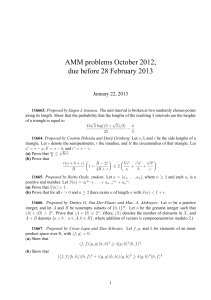
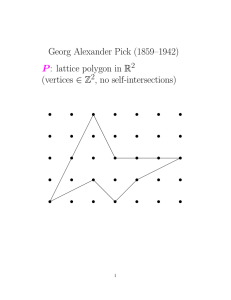
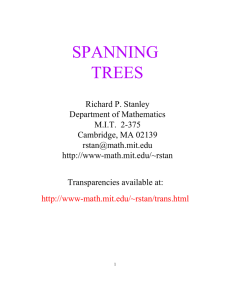
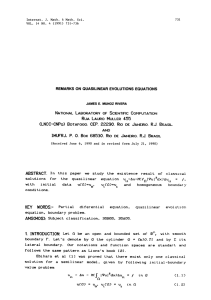
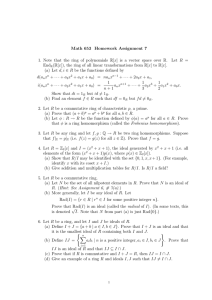
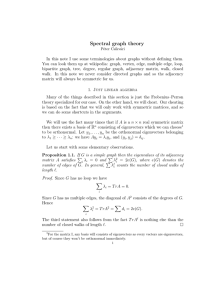
![5.5 The Haar basis is Unconditional in L [0, 1], 1 < 1](http://s2.studylib.net/store/data/010396305_1-450d5558097f626a0645448301e2bb4e-300x300.png)
